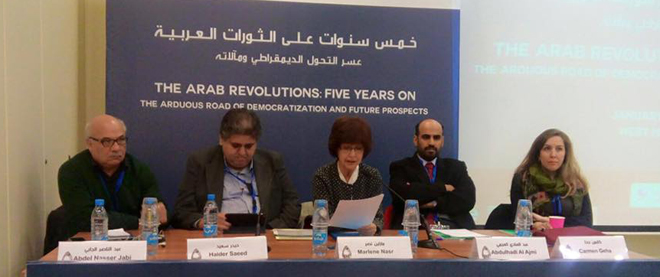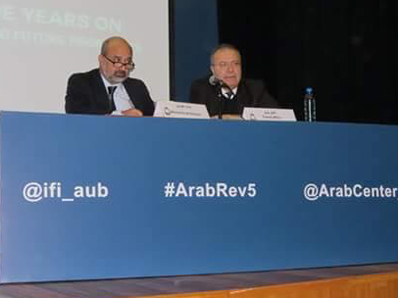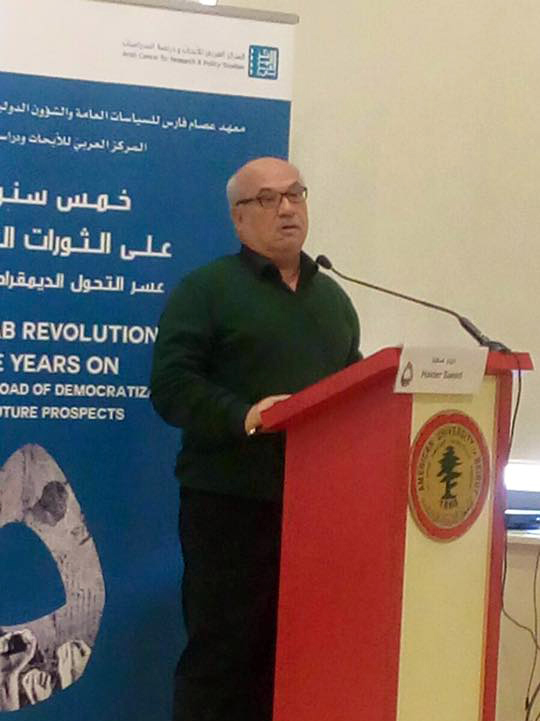 |
| From left to right: Abdel Nasser Jabi, Haider Saeed, Marlene Nasr, Abdulhadi Al Ajmi and Carmen Geha. |
Opening remarks were made by Tarek Mitri of the Issam Fares Institute, and Mohammad Almasri of the ACRPS.
Mitri focused on the spirit of cooperation and shared understanding between both institutes, before giving an overview of the conference program. Mitri pointed to the critical importance in discussing the ambiguities inherent in the term democratization, and its different context across the various Arab states. He praised the conference’s efforts to foster a spirit of calm reflection on the drive for democratization and the obstacles to its path, and observed that the papers chosen were purposely wary of falling prey to apocalyptic readings of disturbances whose dust is yet to settle. Domestic and regional concerns were prioritized over international ones, noted Mitri, with most of the papers trying to understand three aspects of the prevailing conditions in Arab states: the legacy of tyranny; the structural problems of Arab countries, particularly the stoking of tribalism over citizenship; and the administration of the transition itself.”
“2011 was a historic year”, commented second speaker ACRPS’s Mohammed Al Masri, “since it erased the discourse of stagnation and exceptionalism, and the disconnect of new generations, as well as many inherited ideas and assumptions.” The 2011 revolutions, he noted, stunned the world and political observers with the non-violent approach utilized in many countries to overthrow regimes, despite, in some cases, being faced with excessive violence from the regime. Al Masri saw 2011 as a massive explosion deserving a re-reading of society, power, and local relations among other matters. For him, the conference was a confirmation that a new historical period is being founded premised on human advancement and sovereignty, the citizen state, and the citizen’s right to freedom, wellbeing, and stability.
 |
| Left to right: Mohammad Almasri and Tarek Mitri. |
Al Masri then went on to present the results of ACRPS’ Arab Opinion Index, which surveys Arabic public opinion on the Arab revolutions. Presenting the results of the 2015 survey, and comparing them with ones from previous years, the findings indicate that the majority of Arab public opinion still backs the revolution, although the degree of support has fallen over the years. Al Masri noted that the drop in support for the revolution five years on is concentrated among older age groups, while positive assessments are concentrated among the more educated, and those in the countryside compared to urban areas. Negative assessments of the revolution – mainly ones concerned with the overall worsening security, foreign intervention, economic decline, extremist movements, the remnants of the old regimes, and the behavior of political Islam and secularists – did not stymie hopes that the Arab Spring would ultimately fulfil its goals, noted Al Masri.
The conference then broke into two parallel sessions. The first part addressed “The Arab Revolutions Five Years on: A Re-Reading and a Critical Examination” and “Protest Movements as Part of the Arab Revolutions”.
Chaired by ACRPS’s Research Professor Wajih Kawtharani, the first contribution was delivered by Mouldi Lahmar on “Tunisian Revolution and the Other Transformation: Resources, Considerations, and Values”. Presenting his results from fieldwork carried out in 2012, in regions that gave birth to Tunisia’s revolution, Lahmar used the metaphor of transition in chemistry noting how “in chemistry, transition refers to a series of processes that run causally and result in a new positive situation that leaves no possibility for regression, while in political science, possibilities of regression and counterrevolution, of a transition not leading to democracy, and of new conditions to arise are a real possibility”. Mouldi observed that current research dealing with the transition was more theoretical than sociological, in that it lacked a methodology of thinking about transition in itself, rather than the situation to begin with and the situation reached.
From Tunisia to Egypt, the second contribution came from Dina El-Sharnouby in her paper “The Egyptian Revolution and its Impact on the Formation of New Youth Subjectivities”, in which she addressed the impact of the 2011 uprising on youth in Egypt. El-Sharnouby considers the 2011 revolution as an opening to new possibilities for change, shedding light on the emergence of a new youth subjectivity that is affecting Egyptian youth’s political participation and imagination for change. El-Sharnouby also reviewed the stages of youth political awakening in Egypt, with the appearance of the first independent youth movement dating back to 2008, prior to which young Egyptians were more likely to join the parties of the older generation.
Next came Mustapha Al-Teer, with his paper “The Arab Spring and the Democratic Transition: Reflections on the Libyan Experience”. Inferring how Libya’s revolution was not, strictly speaking, entirely a Libyan creation, he went on to discuss the role of Al-Jazeera and that of international powers; the civil society organizations formed after the revolution; the proliferation of political entities and local political parties that lacked ideological differences; the elections, and the role of radio, press, and television channels in Libya. Al-Teer added that many factors hindered the revolution, most importantly the involvement of militias and the growth of armed clashes.
Concluding this session was Al Mustafa’s paper “Syria: From Peaceful Revolution to Armed Conflict”. What brought the revolution to where it is today, asked the researcher, and how does one explain the shift of the Syrian revolution from non-violence to armed conflict? Mustafa offered a number of interpretations to explain this shift, from describing the Syrian revolution as one stemming from the countryside, the poor, and the marginalized standing violently against the city, thus transforming the revolt into a violent one, to accounting the shift to the excessive violence used by the Syrian regime. For Al Mustafa, however, the regime unequivocally bears the real and prime responsibility for Syria’s peaceful revolution spiraling into violence.
Chaired by ACRPS’s Senior Researcher Marlene Nasr, the parallel session started with Haider Saeed’s “On Protest Movements in Post-Tyranny Iraq: The Challenge to Stateism.” Saeed followed the waves of protest movements that broke out in Iraq after the American occupation and the fall of the Saddam Hussein, the most important of these being the protests of February 17 and 25, 2011 in Sulaymaniya and Baghdad respectively, and the protests that erupted in Baghdad and the cities of the south in the summer of 2015 calling for political reform. Saeed stated that these were the two most significant waves of protest in Iraq. He added that protest movements are successful in bringing about political change only once the political component, which usually calls for political liberties, democracy, and the rotation of power, succeeds in incorporating internal demand-oriented components. The success of the Tunisian and Egyptian revolutions resulted from this incorporation, whereas political activists in Iraqi protests, he concluded, failed to achieve this.
From Algeria, Abdel Nasser Jabi in his paper “Algeria: The Fear of Political Change”, shed light on the difficulties confronting political change in Algeria, a country that resisted the Arab tidal waves of change in 2011. Jabi stated that 700,000 Algerians took to the streets in protests in 2015, yet external pressures failed to bring about change. Traditional mechanisms for change failed because the deep state in Algeria was present in force. To illustrate his point Jabi added “We do not know the name of the head of the intelligence service until it changes, even though he has ruled us for 25 years. We are not unlike the USSR where the general secretary-of the Communist Party would rule for a year and then die because he was from a generation that was biologically extinct but politically still alive.”
 |
| Abdel Nasser Jabi |
Kuwaiti Abdulhadi Al Ajami in his paper “The Kuwaiti Mobilization and the Arab Spring: The Dynamic of Mass Mobilization and the Abandonment of Pragmatism” suggests that the Arab spring was in effect detrimental to the political mobilization in Kuwait, which led to a raising of the ceiling of demands. Today, with the setbacks suffered by the Arab Spring states, this mobilization, one that preceded the Arab Spring, finds itself caught between its realistic abilities and the power of the authorities and the counter-revolutionary wave in the Arab world. Regardless, the collective Kuwaiti mind, stressed Al Ajami, has been freed of the chains of authority that were convinced the Arab Spring would not pass through Kuwait.
Concluding the session, Carmen Geha from Lebanon in her paper “The Sectarian Octopus: Mobilization and Demobilization Dynamics in Lebanon's Power-Sharing System”, dealt with the challenges facing mass mobilization for non-partisan protest movements. Her paper presented findings from two empirical case studies. The first, the 2011 movement, that occurred over three Sundays in February and March aimed at bringing down the sectarian system (iskat al nizam al ta’ifi). The second case is the most recent attempt by Lebanese citizen groups to organize protests lamenting the garbage crisis and demanding immediate political reform spearheaded by the “You Stink” movement (tolet rihitkon). Geha stated that political leaders in Lebanon, in addition to being weak, use the power-sharing system to prevent mass mobilization outside the party framework, and that Lebanese official institutions are weak as a result of the lack of a judicial branch and of accountability.
To read a report on the afternoon sessions in English, please click here.